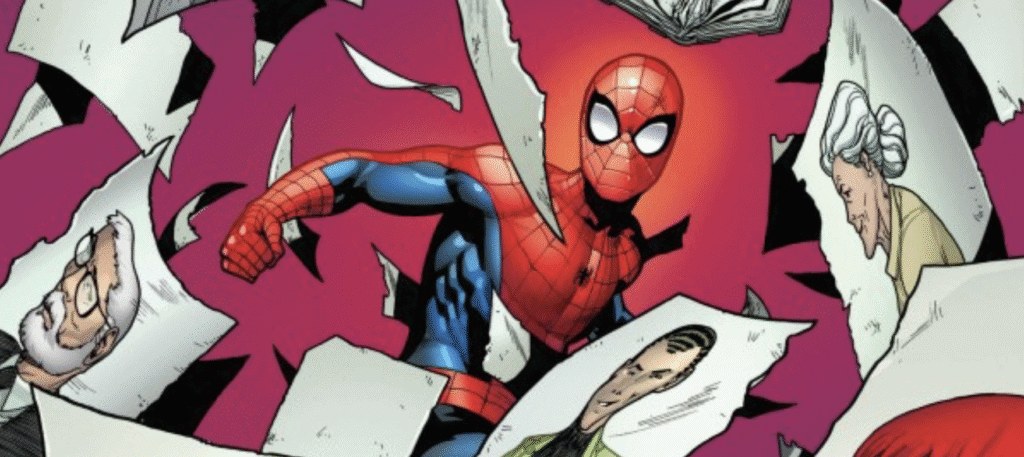The Amazing Spider-Man: Torn #1
Recap
Straczynski is teaming up with fan-favorite artist Pere Pérez (TVA, Venom War: Carnage) to tell a story that takes readers back to Peter Parker’s college days at Empire State University. Expect appearances from Gwen Stacy, Harry Osborn, MJ, and Flash Thompson — plus classic villains and an all-new threat that could shake the Marvel Universe to its core.
Review
J. Michael Straczynski is no stranger to Spider-Man, often hailed as one of the web-slinger’s most celebrated yet divisive writers. His tenure remains a lightning rod for debate surrounding Peter Parker’s relationship to marriage, magic, and maturity—cornerstones of the character’s relatability. Spider-Man: Torn #1 sees Straczynski stepping away from those larger thematic battlegrounds to tell a story set in the character’s distant past, where the exuberance of youth collides with the melancholy of the Bronze Age. The usual sharp wit of his Spider-Man scripts gives way to a slower, more emotionally weighty tone, enriched by the somber artistry of Pepe Pérez. With a near-macabre focus on the stagnant dreams of young adults wrestling with who they will become in a future destined for ruin, Torn is not the triumphant return many may have expected from Straczynski—but it is a fascinating one nonetheless.
That being said, there is still enjoyment to be found. Taking readers back to the late sixties and early seventies, Straczynski places Peter in the midst of his typical college routine. His villains are causing chaos, his professors are nearly as unbearable as his foes, and the blurred lines between friendship and romance leave him stranded in a constant state of social confusion. More than any author in recent memory, Straczynski does a remarkable job evoking what that era would feel like in modernity without sacrificing its aesthetic or identity. Peter’s quips carry a tone more sardonic than clownish, and the dialogue’s formal verbosity feels authentically retro—something that would make Stan Lee proud.
Those nostalgic touches sit atop the story’s true ambition: to delve deeply into the psychology of Peter’s ability to relate and grow through his relationships, his perpetual fear of tragedy keeping him from fully opening up. That aforementioned sarcasm functions as a defense mechanism, allowing him to remain close to his friends without letting them in. It is the kind of insightful character work that elevates Spider-Man’s core qualities beyond the tropes they have been reduced to. Setting this exploration in the Bronze Age only strengthens it, using the past to interrogate how emotional fragility shaped the futures of Peter, Gwen, Harry, and MJ—a group of black sheep who found meaning in each other’s guardedness.
However, a Spider-Man comic requires more than sharp characterization to truly fire on all cylinders. While the opening is high-flying in concept, the pacing soon becomes lethargic, hindered by an art team whose storytelling lacks energy and flow. The panel transitions rarely demand the reader’s attention, and Straczynski’s script lingers in all the wrong places—where moments of warmth and camaraderie could have better sold this friend group to newcomers. Longtime readers can fill in those gaps, but new audiences may find themselves questioning the story’s purpose altogether. Coupled with Straczynski’s familiar reliance on the supernatural—one of his more divisive trademarks—the weaker aspects of his Spider-Man storytelling occasionally resurface where they least belong.
Final Thoughts
In the end, Spider-Man: Torn #1 is a bold but uneven return for J. Michael Straczynski. It is a story rich with introspection, carried by a deep understanding of Peter Parker’s emotional architecture, yet undermined by a sluggish pace and inconsistent visual delivery. For all its missteps, however, it remains a work of genuine intent—one that seeks not to glorify the past, but to dissect it. Whether that dissection resonates will depend entirely on the reader’s willingness to confront the same uneasy truths that have always defined Spider-Man himself.
The Amazing Spider-Man: Torn #1: Not Just a "Nostalgia Thingie"
- Writing - 7.5/107.5/10
- Storyline - 6/106/10
- Art - 6/106/10
- Color - 6/106/10
- Cover Art - 7.5/107.5/10
